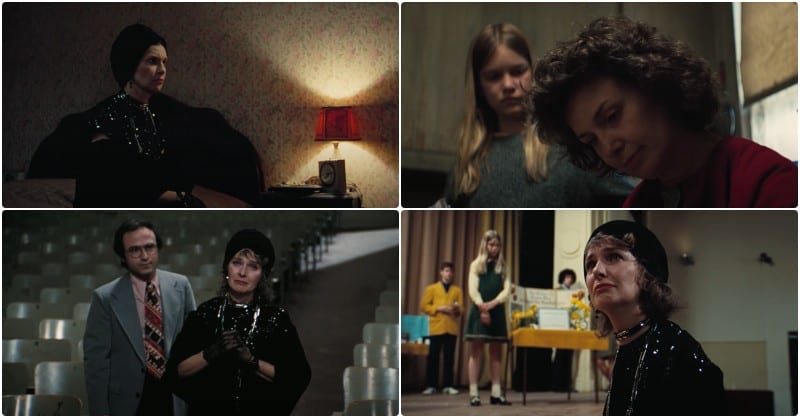
Beyond the Classics is a recurring column in which Emily Kubincanek highlights lesser-known old movies and examines what makes them memorable. In this installment, she breaks down the marvel collaboration between Paul Newman and Joanne Woodward, The Effect of Gamma Rays on Man-in-the-Moon Marigolds.
Joanne Woodward and Paul Newman are one of the Hollywood couples we romanticize the most today, compared to many short-lived affairs between celebrities throughout history. They seemed to support one another fully, but as the new HBO Max series, The Last Movie Stars, shows, their relationship was much more nuanced than we believed from the outside. They fought and had their struggles like any other couple, sometimes even while they worked with each other.
One instance of this was while filming The Effect of Gamma Rays on Man-in-the-Moon Marigolds in 1972. Woodward struggled to portray the difficult mother character that her husband cast her in. That turmoil ended up producing a fraught and emotional performance that is often overlooked when compared to her other powerful performances throughout her career. Yet, she worked hard for this performance, alongside her own daughter and husband. Despite being a worldwide celebrity family, Newman and Woodward were able to dive deep into a working-class, traumatized family in an authentic and unromanticized way in Marigolds.
Originally an off-Broadway Pulitzer Prize-winning play by Paul Zindel, The Effect of Gamma Rays on Man-in-the-Moon Marigolds tells the story of Beatrice (Woodward) and her two daughters Ruth (Roberta Wallach) and Matilda/Tille (Nell Potts, real name Nell Newman). The three live in a dilapidated old house, once a Victorian gem but now constantly dirty, dingy, and chaotic inside and out. Single mother Beatrice has lived a hell of a life. Her husband left her before dying in a hotel, and life doesn’t want to give her the kinds of lucky breaks everyone else seems to have. She stalks the personal ads of the newspaper daily, dreaming of the opportunities she is holding out for rather than coming to terms with reality.
The family gets by on her cold-calling job and takes in boarders in the house, always old and disposed of by their families. Beatrice has bred a terrible environment to grow up in, but Ruth and Tillie are desperately trying to survive without ending up like their mother. Ruth is longing for a romantic relationship and solid social life. Tillie, much more reserved, is focused on all things science, from her class’s retired pet rabbit to her complex science project on how radiation affects marigold plants. Beatrice is supportive of neither of the girls’ desires, encouraging the girls to stay home from school to clean up her mess while she schemes to open a tea shop.
Tillie enters her science project at the science fair, where the parents are supposed to stand on stage with their children. Beatrice is terrified of being laughed at by the other families and prepares for the worst. Ruth vows to go to the school dance despite her mother’s demands that she stay home with their newest boarder, an old woman named Nanny. The film builds to the night of the science fair as Tillie heads to school to prepare her project and Beatrice prepares to be seen by competent families and teachers. Her reputation as “Betty the Loon” growing up certainly still impacts how she moves about the world, as she overdresses for the occasion and hyper-focuses on how she will be perceived rather than supporting her daughter.
Ruth leaves their boarder after fighting with her mother, leaving Beatrice to deal with Nanny before showing up late to the science fair. The whole room stops and stares at Beatrice as she enters the auditorium as if she were performing in a play. Other students laugh and stare at her as she screams, “My heart is full,” the line she’s rehearsed for days to show everyone she is proud of Tillie. She leaves the girls at the school, walking out as quickly as she came. At home, she kills Tillie’s pet rabbit in retaliation for the embarrassment she felt at school, ending the story in probably the most hopeless place possible. Yet, Tillie refuses to succumb to her mother’s soul-crushing disposition. She looks out at the starry sky, vowing she does not hate the world.
The original Zindel play required a realistic perspective from its film director and performances. Woodward and Newman entered Hollywood just as the traditional, sparkly portrayal of human life was dying out. As they grew in their acting careers, their Method acting training became their key to transitioning into the dramatically new kinds of films being made in Hollywood in the 1960s and 1970s. They craved roles of substance and importance, while Newman also sought out down-to-earth stories to try his hand at directing.
His directing debut starred Woodward in Rachel, Rachel, released in 1968. The film shows a single woman in her thirties as she has a sexual awakening in a small town. Like Newman’s other directing endeavors, Rachel, Rachel aimed to give Woodward the kind of role and story she needed to show off the talent that he knew she had. Marigolds had the same purpose. However, this role was painful to play, sending Woodward into a depressive spiral that nearly ruined their relationship. Unlike her role as Rachel in 1968, Woodward wasn’t tasked with making the audience love a woman she herself liked to portray. She hated Beatrice and everything about her. Afterward, she recalled, “I was so depressed and suicidal during that film I couldn’t stand it. I hated the way I looked, I hated that character, what she did to her children.”
Yet, Woodward still finds a way to prevent Beatrice from being an all-out villain. When finding out bits and pieces of her past, Woodward delivers those lines of backstory as matter-of-fact information, as Beatrice should. Her facial expressions, though, show a woman who may want the world to think she doesn’t care but can’t help but let her real feelings show through. In the climax of the movie, as Beatrice walks down the aisle of the school auditorium, Woodward turns this act of selfish performance into a moment everyone watching pities and feels for Beatrice, even her daughters. Despite her contempt for the character, Woodward put everything into Beatrice just as Newman knew she could.
Newman was a worldwide celebrity when making Marigolds, but one of the aspects everyone loved about him was that he never acted like one. He was extremely modest and aware of the luck that played a large part in his career. He was, above all, sensitive, and if that didn’t always come out in his acting, it always came out in the movies he directed.
The Marigolds play refuses to allow the audience any opportunity to feel for Beatrice. It shows her murdering her daughter’s rabbit and delivers horrific lines, there is no sense of humility in Beatrice. Newman set out to change that in his adaptation while still staying true to the original play’s point of showing a disturbed and poor mother’s effect on her children. He shifted the perspective slightly to make Beatrice more centrally focused, rather than Tillie like she is in the play. Whether or not the omission of showing Beatrice kill her daughter’s pet was a decision made by Newman or not, it had a huge effect on how the audience sees Beatrice in the end. The murder happens off-screen, but her reaction to her consequences says so much to the audience that showing the act might not have.
She lets Tillie find her dead rabbit while she laments about the business she dreams of building to Ruth, who looks at her mother with a knowing look, a look that shows she’s given up believing in her mother. No words are exchanged as Tillie brings her dead pet outside and sets him in front of her mother. Beatrice just purses her lips and looks at Tillie, waiting for her to cry or lash out at her. Her retaliation doesn’t get a rise out of her daughter, though, which is the true act of rebellion for Tillie. She refuses to allow her mother to taint her optimistic view of the world, which makes for a bleak ending rather than an all-right disturbing one. Newman was dying to understand this family, each member of it, rather than exploit it.
It’s a shame that the marketing for the movie did the exact opposite. As Ariel Schudson points out in her essay about the movie for Beverly Cinema, all the posters and taglines completely diminish Beatrice to being a “bitch,” rather than the nuanced character Newman and Woodward developed. In one poster, the tagline reads, “Life’s been a real bitch to Beatrice Hunsdorfer. And vice versa.” Newman wanted the opposite reaction to his film. Beatrice was a role that could have made Woodward another Oscar winner if marketed correctly. Instead, she was made into a spectacle, the thing Beatrice herself was terrified of being.
The Effect of Gamma Rays on Man-in-the-Moon Marigolds didn’t ruin Newman and Woodward’s marriage or their relationship as collaborators. Newman still prioritized directing projects that made his wife the focus of the film, but never in roles as damning as Beatrice. His daughter Nell never acted in a movie again but still looks back on the film in The Last Movie Stars with appreciation and admiration towards her parents.
Truly marveling at Woodward and Newman’s relationship during a tumultuous period, rather than romanticizing it as much of history has, feels like a much better way to appreciate their talent and love for one another. Despite the strain on and off set during the early 1970s, they remained married until Newman’s death in 2008. Similarly, this movie tells a much more impactful story about surviving poverty and the hopelessness that accompanies it than any feel-good movie could, which is why it still stings to watch today.
You can stream the series The Last Movie Stars on HBO Max.
Related Topics: Beyond the Classics

